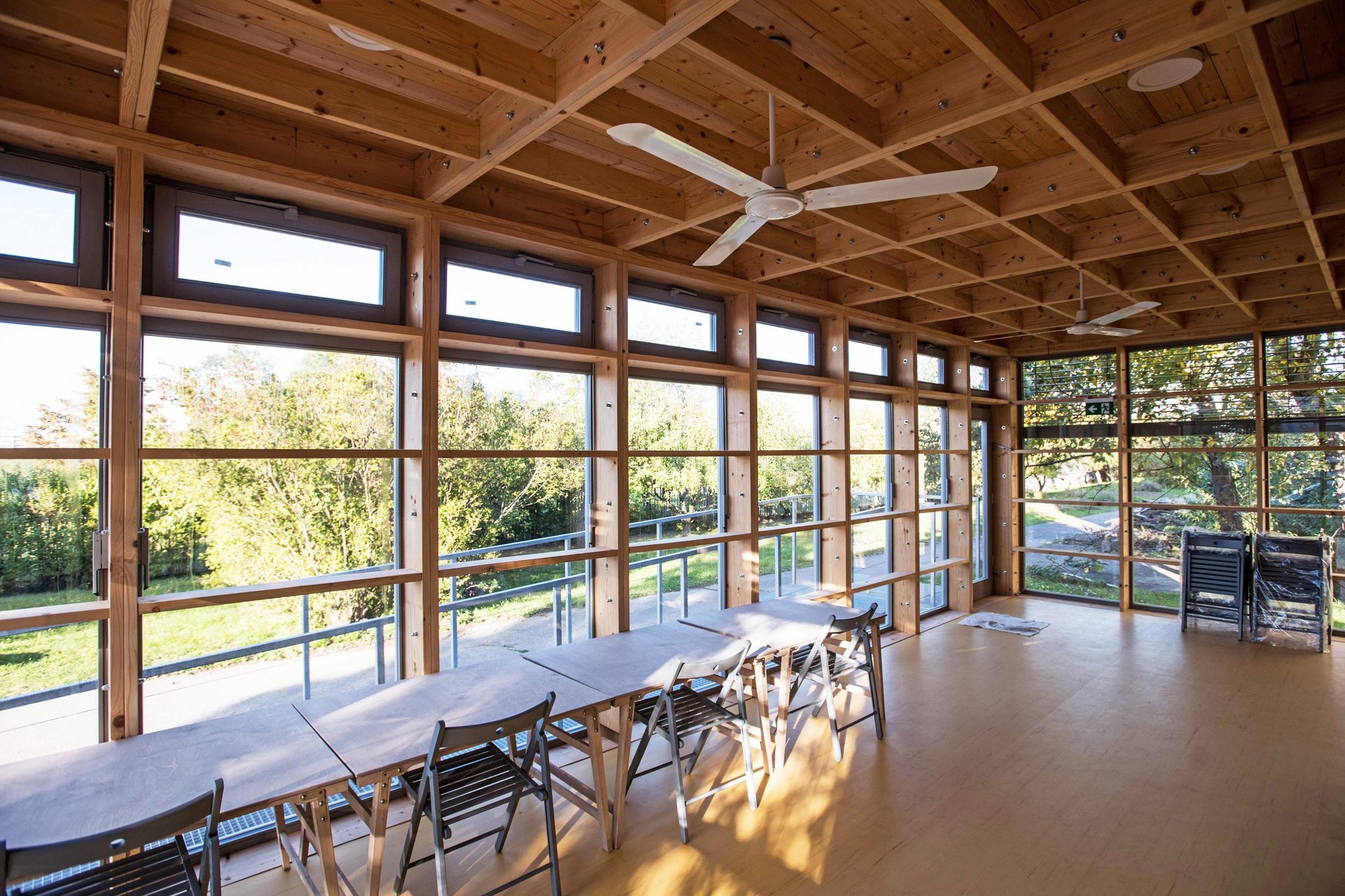Outdoor classrooms, proof of the need for various teaching methods
Ve Flowers & Dinosaurs University we help create strong and independent personalities from children. We do it with the help of books, resp. topics that carefully selected titles open and thus broaden the horizons of children. Sometimes even parents. In our blog we want to inspire you with people and projects that have a similar goal, they just fulfill it a little differently. One of them is Filip Kuchař from the City Hall. of the City of Prague and architects David Kubík and Petr Štambach.
"Children and teachers enjoy it," says Filip Kuchař, head of the project concept department at the City of Prague, about the year-round outdoor classrooms. "And that's the most amazing feedback." In the interview, he explains why it's important to have different types of teaching and tailor them to the individual needs of the students.
The teacher enters the room. Until now, he relied mainly on frontal teaching, but as he walks through the outdoor classroom, he touches it, his eyes reflect the enthusiasm. He is already wondering what can be done here.
This is how the usual first experience with a year-round outdoor classroom looks like, a project that Filip Kuchař from the City of Prague came up with. Together with architects David Kubík and Petr Štambach from the Hutě architecture, Martin Rajniš gave it a concrete form and atelier344 then realized it. Target? Expand the possibilities of education - improve the spaces in which teaching takes place, and inspire teachers and students to the unsuspected. Mission accomplished.
What made you think that it might be worth teaching children differently than we are used to?
What probably everyone who is not blinded does not hide behind prejudices and is not afraid to look for inspiration in the past. After all, many things only improve and improve over time. The same is true of learning outdoors. I realized this when the principal of a school in Prague 7, Mr. Bohumil Kettner, dedicated me to his amazing book Who Was Eduard Štorch, which is devoted to the life of pedagogue, writer and archaeologist Eduard Štorch. Few people know that he, as a teacher in the 20s, initiated, for example, the first school ski courses or in 1926 founded so-called "children's farms" on Libeň Island to verify in the field that outdoor education is more effective than in school. .


What were your next steps?
Then the search for inspiration for the form of space began, which would create a place for children directly in nature. One where they would enjoy gaining new knowledge. Something that immediately in each evokes the idea of class, but different than everyone expects, attractive and arousing curiosity. Fortunately, that didn't last long. At the vernissage of the Martin Rajniš Architecture Ironworks in DOX on June 27, 2014, my gaze stopped at the Steak-house design model. I knew immediately that this was what I was looking for. Subsequently, I met with architects David Kubík and Petr Štambach, and from a meeting of three creatives, the first amazing seasonal classroom for a primary school in Prague 7 was born, where I then supported the development of schools.
What was the feedback like?
We were full of tension about how the students would react to the class. Subconsciously, we were constantly wondering if the teaching in the school garden would distract them, but from the first lessons we only had positive feedback from the teachers. On the contrary, they said that children are much more relaxed and focused in this classroom. That made us very happy. In addition, we noticed that this space has a positive effect on teachers, who under his influence began to come up with ideas for new teaching methods.
Are you looking for inspiration abroad?
Yes, inspiration can be found at every step, and therefore abroad. We regularly organize inspiring tours for Prague principals not only to interesting schools and educational facilities in our country, but we also try to discover and visit inspiring educational places and exhibitions abroad. It is interesting to follow the settings of their education systems and school funding, as there are many stimuli to be found there. Especially in the simplicity of the legislative conditions for the operation of schools, which allow principals west of us to manage schools more efficiently. But also, for example, in enough table places for all activities that schools have to provide today (IT administrator, PR specialist, project worker, etc.), and which we know about, but for schools we still can not allocate in the tables.


Why is it important to have other types of schools as well?
From my point of view, it is even necessary to have other types of schools, because we humans are each different. Although we often proclaim how humans differ from animals in their diversity, I unfortunately feel that it is increasingly our effort to create uniform systems for all. But that will kill our creativity. When Hejný began to popularize the method for teaching mathematics, I remember the DOX conference saying that this method is not for everyone, that it suits someone, while that suits classical teaching, and that children should have the choice to learn mathematics the way it is natural for them. Well, you see, a few years have passed and today I read ideological pamphlets that whoever of the children will not have the opportunity to learn the mathematics of Hejný by the method will not actually learn it well. The same came under inclusive measures. We recruit all children with different educational needs into one class to get rich - terrible and sad nonsense. In addition, today we read that it will be necessary to reduce the number of assistants. I don't see any happy ending here.
How could the situation improve?
If I mentioned foreign inspirations, it would be enough for authors and promoters of inclusion in its current form to drive 150 km to Leipzig, where they have a model inclusive school. There is a normal and a special school in one building. Children from a special school attend selected classes in primary school, where they learn subjects that they are able to complete. In this way, mainly diverse educational needs can be supported. However, this requires a lot of interest, having open eyes, not having prejudices and ideas to communicate in a wider group of those who will then be affected by various projects, innovations or measures.
Outdoor classrooms are not just a matter of summer. They can also be year-round. How does such an outdoor classroom work in winter?
As good as in summer. At the beginning of my journey to support learning in outdoor classrooms, the classroom was seasonal. The establishment of year-round classrooms was due to the decision of the OP PPR managing authority, which in its call for modernization of schools and classrooms set the condition that only pre-school educational institutions can apply for a seasonal outdoor classroom and primary schools can apply for an outdoor classroom if interested. it will be possible to educate all year round. And so I asked the already proven designers Kubík and Štambach from Huta the architects Martin Rajniš, if we would not prepare together for the school from our seasonal classroom and its "sister", a classroom for year-round operation. And it worked. A classroom was created, which has underfloor heating, is wooden and is glazed on three sides and open to the surrounding nature. We also managed to comply with other technical parameters so that it means as few worries as possible for schools. It is not a permanent building, but it has remained, just like a seasonal one from the point of view of building authorities, a mobile classroom, so there are no worries about securing a building permit. In addition, this classroom is equipped with a wheelchair ramp, ensuring barrier-free access for all. Only in unfavorable times is it more difficult to maintain and clean.


Is the aim of outdoor education also to strengthen children's relationship with nature, or is it just a welcome side effect?
In fact, I admit that the overall vision of outdoor classrooms was more of a welcome side effect. Our main goal was to create a unique and inspiring space that would positively tune children to education by changing the environment, through nature. In addition, as I mentioned, which was a very pleasant surprise for me, there was also a change in teachers' thinking about how to teach - how the class inspired them to change their educational approaches. But if I return to your question, then there is a good chance that children will remain in adulthood the memory of the difference between learning with ease in nature and spending class hours in a stone building. And perhaps they will look more for opportunities to transfer their life activities to nature.
So how do educators react to outdoor classrooms?
Your question is not so much for me as it is for the educators themselves. Therefore, I would like to quote a colleague from our hospital kindergarten at Thomayer Hospital in Prague 4, Mgr. Vladimíra Malinová and Bc. Jana Landová, who were the first to enter the seasonal outdoor classroom and after a year of use wrote us:
"The classroom has proved its worth especially for children diagnosed with autism spectrum disorders, children feel safe in an enclosed space. The furniture of the outdoor classroom is very well chosen, children can sort and manipulate various materials, their gross and fine motor skills, cognitive functions develop, which contributes to the overall development of personality. We use the classroom to calm children with various diagnoses, such as ADHD, dysphasia. Often the classroom will provide us with shelter in bad weather, we can work here with children even in the rain or on hot days and thus be as fresh as possible. At a time of emergency, when kindergartens would be in continuous operation and free movement was restricted, the outdoor classroom became our sure refuge. The classroom serves us very well, we can no longer imagine that we should not have it. "
You know, we also built seven year-round classrooms in our elementary schools last year. When I return to them, it is wonderful to observe how each inside is arranged differently, used differently, exactly according to the needs and wishes of individual schools.


Is there anything at all blamed on the project?
I have not encountered any criticism since the autumn of 2014, when the first outdoor classroom was built. Perhaps this is my approach, which I have already mentioned, and thanks to which we communicate most other ideas, comments or complaints with future users at the time of project preparation. In addition, my goal is always that projects can continue to develop according to the users themselves. The great advantage of all the outdoor classrooms that we have prepared for schools so far is also that they are based on a modular system. If necessary, it is not a problem, for example, to enlarge or reduce in any direction.
If you are excited about outdoor classrooms and are looking for a way to educate your child in a fun and non-violent way, take a look Flowers & Dinosaurs University, subscriptions to children's books from around the world, which make children strong and independent personalities.
Under the line
- The architect Petr Štambach, one of the authors of the outdoor classroom, also uses the studio344 to create equipment for school gardens. You can view the catalog under this link. (http://www.atelier344.cz/wp-content/uploads/2019/07/Katalog_A5_online.pdf)

